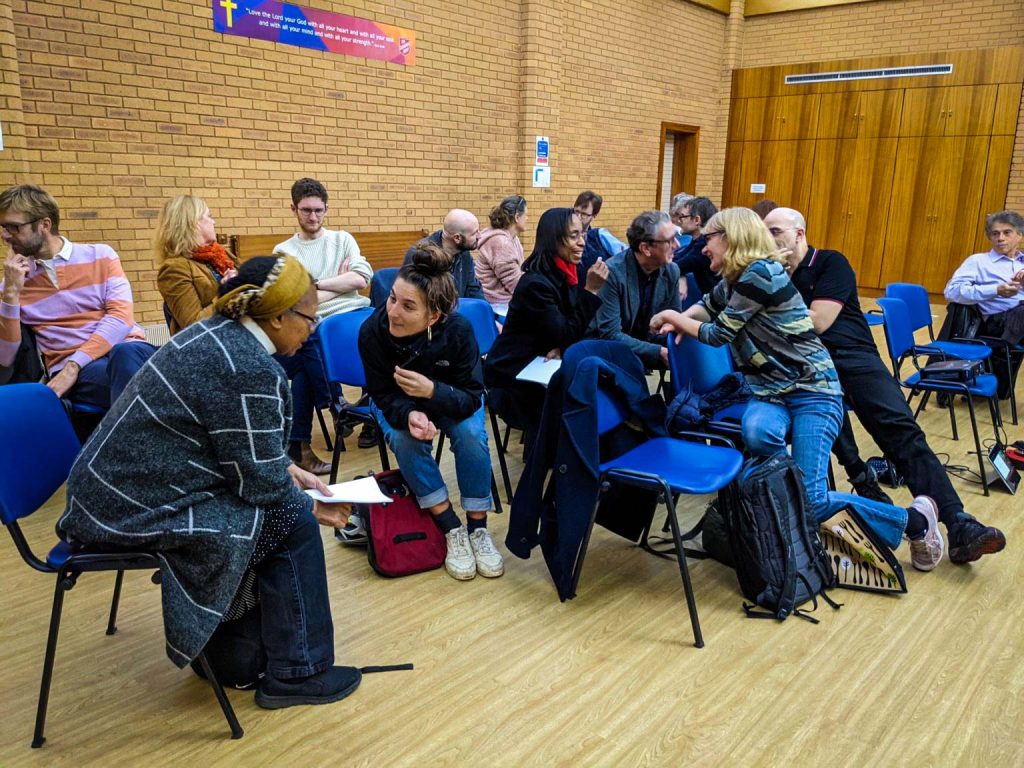Everyday people can make a difference in their communities. This is the vision that Community Land Trusts (CLTs) build upon. They are groups of local people who create community assets. And they provide an innovative solution to the housing affordability crisis. Sounds pretty cool, right? We spoke to Peg Alexander and Sophie Haggerty from the Community Land Trust Network to learn more about the CLT movement and its potential.
Before we dive into the details, let’s clarify what exactly CLTs are. A Community Land Trust (CLT) is a legally defined group of everyday people from a range of backgrounds who obtain land in their area and develop it for the benefit of the local community. Anyone in the (geographically) defined community can become a member of the CLT. Sometimes CLTs also grow out of a local government authority that wants to promote community-led housing.
Generally, CLTs aim to own (or at least use) the land they obtain forever, taking it off the market entirely. The primary goal of a CLT is not the creation of financial wealth but community assets, like village halls, gardens, community shops, or – most commonly – affordable housing.
Whatever project a CLT decides to proceed with, it will be managed by a board consisting of CLT members. This board often consults with experts (such as officials and housing experts) and members of the wider community. This structure enables the CLT to protect community interests and make decisions based on real local needs.
The CLT movement originated in the US but has reached and thrived in Europe too. As of 2020, there are at least 347 active CLTs in England and Wales alone.
The Community Land Trust Network
Like many community-led initiatives, CLTs often find themselves in need of support. In England and Wales, they have found it in the form of the Community Land Trust Network. The network advocates for the CLT movement, educates opposers, and provides individual CLTs with services, like legal support, guidance, and relevant resources.


Eager to learn more about CLTs and their impact, we reached out to Peg Alexander, Campaigns & Business Development Manager, and Sophie Haggerty, Campaigns Officer, at the Community Land Trust Network. They happily agreed to share their knowledge with us and make the case for CLTs.
The Case for CLTs
Most CLTs create affordable housing on their land; an asset many communities desperately need. But do we really require CLTs to provide affordable homes? Or would it make more sense to fix the broken social housing system and invest in larger developments that could house thousands of people? A legitimate question, Peg and Sophie agree. However, they serve us up some solid reasons why CLTs are needed.
More Secure Than Social Housing
Firstly, they clarify that – particularly in England and Wales – solely investing in the social housing stock would be tricky.
Why? Due to a policy introduced decades ago, called the Right to Buy. It allows council tenants to purchase the property they live in. In 2015, this right was even extended to tenants of housing associations. This extension is known as the voluntary Right to Buy. Through these policies, thousands of public units have entered (and are still entering) the private, profit-oriented market.
In addition, many of the units left, Peg tells us, are not really affordable either. On certain homes, the council can (and does) charge up to 80% of market rents. The social housing market is “very commercially minded now,” Peg summarises.
This is where CLTs can help. CLTs have community interests at heart and ensure that the housing they provide is and stays genuinely affordable. How? “CLTs – through our lobbying work actually – can make use of an exemption from the voluntary Right to Buy,” Sophie reveals, meaning CLT homes can be protected from being sold on the general market. They remain with the community and off the market.
CLT residents still have chances to own their homes. However, if residents want to sell up, an individually designed resale formula applies which, for instance, gives the CLT the first right of purchase or allows it to establish affordability restrictions. Through this mechanism, CLTs can maintain genuine affordability over decades.
Community at Heart
CLTs are also real wizards at recognising community needs. Peg explains that the great thing about CLTs is that they don’t consist of housing professionals wanting to maximise profits and minimise efforts. Instead, Peg stresses:
“They are people who go: ‘Do you know what? That bit of land that I walk past every day when I take my kids to school, or when I go to the shops, that could have housing on it, and we want it to have housing on it. And we want it to be affordable housing. And we also want it to just be for people in our local area.’”
An added plus: by owning, running, and living in the homes, locals effectively fight gentrification and touristification, avoiding being outpriced by tourists, investors, or wealthier citizens.

NIMBYs
NIMBYs often present a hurdle to new (housing) developments but hardly ever to CLT projects. Since CLTs acknowledge a community’s needs, they cater for those who otherwise would oppose development. CLT projects are of high value to the area and often high in quality, which reduces opposition. As CLT projects are seldomly obstructed by NIMBYs, they also encounter a generally lower planning risk than regular developments.
A Sound Investment
But that’s not all. Community-led homes have proven to boost residents’ wellbeing, and they are also great for our pockets. Research has shown that each £1 invested in community-led home projects results in at least £1.80 of benefit.
The Challenges
So, what’s the catch? Why are CLTs not yet mainstream? There are a few barriers, Peg and Sophie tell us, that are holding the movement back.
Let’s Talk About Land
Generally speaking, there are many different routes via which a CLT can acquire land, such as regular purchase, purchase at a discounted rate, land donations from individuals or entities, or land disposals by government entities like local authorities. You might now ask yourself: “Is that possible in a huge metropolis, like London, where land is scarce and super expensive?”
Peg and Sophie agree that finding land for CLTs in dense urban areas is tricky. However, they believe that it ultimately boils down to strong relationships and getting your foot in the door when land becomes available. Peg explains:
“A big part of what they need to do is have good relationships with the local authorities, so that they can get access when land, particularly publicly owned land, comes up.“
To survive in dense urban environments, CLTs also need to become a little creative when it comes to picking plots. Peg and Sophie give three examples of urban CLTs who are truly thinking outside the box:
Tricky Plot: Crystal Palace CLT, based in the London Borough of Croydon, has secured a site via land disposal from their local authority on an awkwardly shaped site on a slope. There they now want to develop affordable, low-energy homes as well as a community garden.

New Opportunities: Sophie, on the other hand, tells us that NW3 CLT, the London CLT she is part of, saw an opportunity in a hopeless situation: “How they got land was, the building that the council owned burnt down, and they said, ‘we want to get this redeveloped. But we want to specifically appoint a community group to do that and not a private developer’.”
Innovative Use: Lastly, Peg adds, there is also the option of pepper-potting, i.e., incorporating CLT homes among “normal”, market-priced units. Solar Avenue is an example of such an approach.
What About the Price Tag?
Financing CLT homes presents another hurdle. Peg elaborates: “For a lot of CLTs and community-led housing schemes the problem is that first bit: the build-up to the point at which you start building.”
Before putting shovels in the ground, you need to pay for architectural designs, land surveys, and planning permission – and, of course, purchase the land. Gaining access to money is not a walk in the park, but luckily the Community Land Trust Network and its partners are there to help. Click here and here for more advice on how to finance CLT projects.
Misconceptions
Despite CLTs’ potential, Peg and Sophie also tell us that many people underestimate the movement’s power.
“A lot of people think of CLTs as community groups, because they’re often made up of the community, and say, ‘how did they get money?’ But of course, they’re just like any other social enterprise or individual homebuyers. They can get a loan,” Sophie explains. As soon as they have received planning permission, that is – the initial costs still present a hurdle.
Another misconception is that it takes CLTs longer than private developers to complete a project. Interestingly, a recent study has shown that communities and developers both take an average of six years from start to finish.
Outlook
These and other hurdles are what Peg, Sophie, and the Community Land Trust Network want to overcome. Their main ambition is to mainstream the CLT movement and ensure “that every community that wants a CLT has got a CLT”.
They are also ambitiously working towards getting the Community Housing Fund renewed, a crucial financing instrument for community-led housing schemes, like CLTs. And the Community Land Trust Network wants to encourage the establishment of non-housing related CLTs, i.e., groups that want to develop village halls, community pubs, and the like, or explore wildlife and agricultural uses.
CLTs in a Nutshell
Community Land Trusts have a lot of potential. They empower communities to develop and manage projects that truly benefit them. They efficiently tackle the housing affordability crisis by taking entire plots of land off the commercially minded market. In fact, CLTs have such potential that even NIMBYs are hesitant to complain. However, as the movement advances, supporters stumble across several hurdles. Urban dwellers need to search dense cities for available space. CLTs in general struggle to finance their initiatives, and people’s misconceptions certainly don’t make things easier. We are curious to see the movement grow in the years to come. With a smile, Peg promises “some quite interesting developments”.
Resource Hub
If you are curious about the CLT movement or are even considering setting up a CLT, we encourage you to take a look at these resources:
- Check this out to learn how CLTs can engage with their local government.
- Here you find case studies of CLTs acquiring available land.
- This platform was co-created by the Community Land Trust Network and explains how to successfully implement a community-led housing project.


